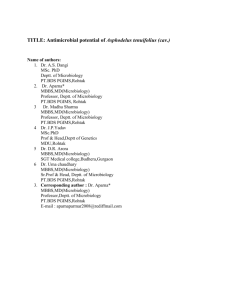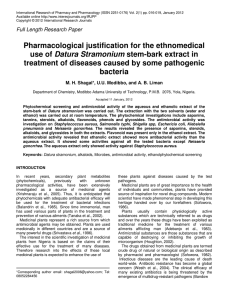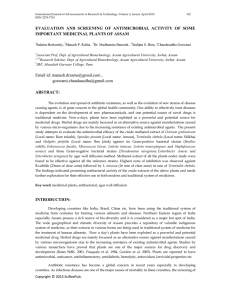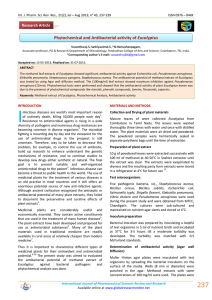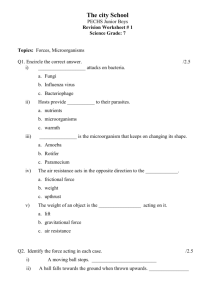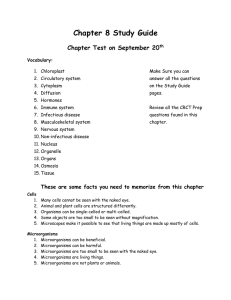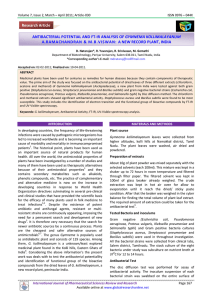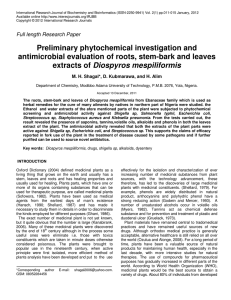Prosopis cineraria
advertisement
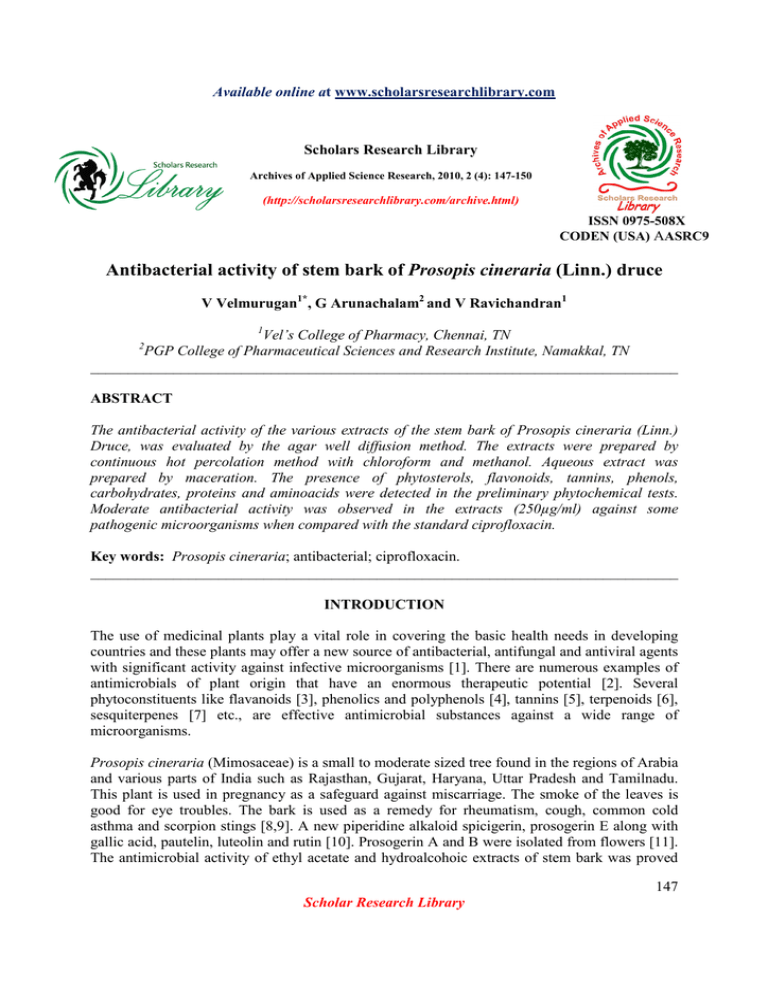
Available online at www.scholarsresearchlibrary.com Scholars Research Library Archives of Applied Science Research, 2010, 2 (4): 147-150 (http://scholarsresearchlibrary.com/archive.html) ISSN 0975-508X CODEN (USA) AASRC9 Antibacterial activity of stem bark of Prosopis cineraria (Linn.) druce V Velmurugan1*, G Arunachalam2 and V Ravichandran1 1 Vel’s College of Pharmacy, Chennai, TN PGP College of Pharmaceutical Sciences and Research Institute, Namakkal, TN ______________________________________________________________________________ 2 ABSTRACT The antibacterial activity of the various extracts of the stem bark of Prosopis cineraria (Linn.) Druce, was evaluated by the agar well diffusion method. The extracts were prepared by continuous hot percolation method with chloroform and methanol. Aqueous extract was prepared by maceration. The presence of phytosterols, flavonoids, tannins, phenols, carbohydrates, proteins and aminoacids were detected in the preliminary phytochemical tests. Moderate antibacterial activity was observed in the extracts (250µg/ml) against some pathogenic microorganisms when compared with the standard ciprofloxacin. Key words: Prosopis cineraria; antibacterial; ciprofloxacin. ______________________________________________________________________________ INTRODUCTION The use of medicinal plants play a vital role in covering the basic health needs in developing countries and these plants may offer a new source of antibacterial, antifungal and antiviral agents with significant activity against infective microorganisms [1]. There are numerous examples of antimicrobials of plant origin that have an enormous therapeutic potential [2]. Several phytoconstituents like flavanoids [3], phenolics and polyphenols [4], tannins [5], terpenoids [6], sesquiterpenes [7] etc., are effective antimicrobial substances against a wide range of microorganisms. Prosopis cineraria (Mimosaceae) is a small to moderate sized tree found in the regions of Arabia and various parts of India such as Rajasthan, Gujarat, Haryana, Uttar Pradesh and Tamilnadu. This plant is used in pregnancy as a safeguard against miscarriage. The smoke of the leaves is good for eye troubles. The bark is used as a remedy for rheumatism, cough, common cold asthma and scorpion stings [8,9]. A new piperidine alkaloid spicigerin, prosogerin E along with gallic acid, pautelin, luteolin and rutin [10]. Prosogerin A and B were isolated from flowers [11]. The antimicrobial activity of ethyl acetate and hydroalcohoic extracts of stem bark was proved 147 Scholar Research Library V Velmurugan et al Arch. Appl. Sci. Res., 2010, 2 (4): 147-150 ______________________________________________________________________________ with two gram positive (S. aureus and S. epidermis) and two gram negative strains (E. coli and K. pneumonia) by agar diffusion method. In our present work we extended the study to screen the antimicrobial activity against nine different bacterial strains. MATERIALS AND METHODS Plant material collection The stem bark of Prosopis cineraria was collected from Cuddalore district of Tamilnadu in the month of October 2008 and was authenticated by Dr. M. Raghuram, Asst. Professor, Acharya Nagarjuna University, Guntur, Andhrapradesh. The bark was air dried to a constant weight and made into coarse powder. Preparation of the extracts About 450 g of the coarse powder was extracted with ethanol followed by chloroform by continuous hot percolation method (Soxhlet apparatus). The marc was then macerated with water to get aqueous extract. All the extracts were then evaporated under reduced pressure and they were stored in refrigerator till use. Phytochemical studies All the extracts were subjected to preliminary phytochemical screening to identify the constituents present in them [12, 13]. Microorganisms A total of eight bacterial and two fungal species were used in this study. Microorganisms were procured from Microbial type culture collection (MTCC), Chandigarh, National collection of industrial microorganism (NCIM), Pune and American type culture collection (ATCC). The list of microorganisms used in this study is included in the Table 1. Table 1. Antimicrobial activity of the extracts of Prosopis cineraria stem bark S. No Microorganisms 1. 2. 3. 4. 5. 6. 7. 8. 9. S. typhi (ATCC 12176) B. Lintus (NCIM 2018) K. pneumonia (NCIM 2707) S. griseus (NCIM 2623) B. subtilis (NCIM 2063) S. aureus (ATCC 29737) S. albus ( NCIM 2178) E. coli (ATCC 10536) P. aeruginosa (NCIM 2206). Conc. of extract (µ µg/ml) 250 250 250 250 250 250 250 250 250 Chloroform extract (mm) 9 6 6 6 7 10 9 11 6 Zone of inhibition Aqueous Methanolic extract (mm) extract (mm) 13 10 16 11 12 13 11 11 12 12 13 13 14 12 14 9 15 16 Standard ciprofloxacin 100 µg/ml 32 29 33 30 33 34 31 40 35 Antimicrobial activity Agar well diffusion assay All the extracts were dissolved in DMSO (1%) to get a concentration of 250µg/ml. Agar plates were used for the study using cup plate method. The microorganisms were inoculated on the agar medium by spread plate technique. Four wells were bored in each plate and 10 µl of the extract samples were added in the well plate. The inoculated plates were incubated at 37°C for 24 h. 148 Scholar Research Library V Velmurugan et al Arch. Appl. Sci. Res., 2010, 2 (4): 147-150 ______________________________________________________________________________ Antimicrobial activity was evaluated by measuring the zone of inhibition against the test organisms. All the assays were carried out in triplicate and the results recorded as mean ± SEM of the three experiments. Ciprofloxacin at the concentration of 1 mg/ml (10 µl/well) was used as standard. RESULTS AND DISCUSSION The methanolic and aqueous extracts of the stem bark of Prosopis cineraria exhibited moderate antibacterial activity with all the tested strains of microorganisms at 250 µg/ml concentration on comparison with the standard ciprofloxacin. The obtained activity may be due to the presence of flavonoids and tannins (presence is confirmed by the preliminary phytochemical studies). Further studies are under progress to characterize the active principles. CONCLUSION Since ancient times, plants have been a veritable source of drugs. However, man tends to ignore the importance of herbal medicine. Recently, much attention has been directed towards extracts and biologically active compounds isolated from popular species. Different extracts from traditional medicinal plants have been tested to identify the source of the therapeutic effects. Some natural products have been approved as new antibacterial drugs, but there is still an urgent need to identify novel substances that are active towards pathogens with high resistance. Multiple drug resistance has developed due to indiscriminate use of commercial antimicrobial drugs that are commonly used in the treatment of infectious diseases, making it a global growing problem. There is an urgent need to develop new antimicrobial drugs for the treatment of infectious diseases from medicinal plants, which may be less toxic to humans and possibly with a novel mechanism of action. Acknowledgement Authors are thankful to the Department of Biotechnology, KMCH College of Pharmacy, Coimbatore, for their kind help in completion of this work. REFERENCES [1] D. Munoz-Mingarro, N. Acero, F. Llinares, J.M. Pozuelo, A. Galan de Mer, J.A. Vicenten, L. Moralese, L.F. Alguacile, C. Pereze, J Ethnopharmacol, 2003, 87 (2-3), 163-167. [2] J. Parekh, S. Chanda, Afr. J. Biol. Res., 2007, 10, 175-181. [3] H. Tsuchiya, M. Sato, T. Miyazaki, S. Fujiwara, S. Tanigaki, M. Ohyama, T. Tanaka, M. Iinuma, J Ethnopharmacol, 1996, 50, 27-34. [4] T.L. Mason, B.P. Wasserman, Phytochemistry. 1987, 26, 2197-2202. [5] C. Ya, S.H. Gaffney, TH. Lilley, E. Haslam, Carbohydrate - polyphenol complexation. In : R.W. Hemingway, J.J. Karchesy, (Ed.), Chemistry and significance of condensed tannins (Plenum Press, New York, 1988) 553. [6] M. Scortichini, M. Pia Rossi, Journal of Applied Bacteriology, 1991, 71, 109-112. [7] N. Goren, H. Woerdenbag, C. Bozok-Johansson, Planta Medica,1996, 62, 419-422. 149 Scholar Research Library V Velmurugan et al Arch. Appl. Sci. Res., 2010, 2 (4): 147-150 ______________________________________________________________________________ [8] S.K. Bhatacharjee, Hand book of Medicinal plants, Pointer publication, Jaipur, 2001, 3rd ed, 284 [9] R.P. Rastogi, BN. Mehrotra, Compendium of Indian Medicinal plants: A CDRI Series, Lucknow, Publication and information Directorate, New Delhi, 4th vol, 1995, 597. [10] A. Hussain, O.P. Virmani, Dictionary of Indian medicinal plants, Central institute of medicinal and aromatic plants, Lucknow, 1992, 1st ed, 376. [11] K.R. Kritikar, B.D. Basu, Indian medicinal plants, 1987, 2nd ed, 910-912. [12] K.R. Khandelwal, Practical pharmacognosy, Nirali Prakashan, Pune, 2007, 17th ed, 149. [13] C.K. Kokate, Practical pharmacognosy, Vallabah Prakashan, New Delhi 1994. P.107-123. 150 Scholar Research Library
